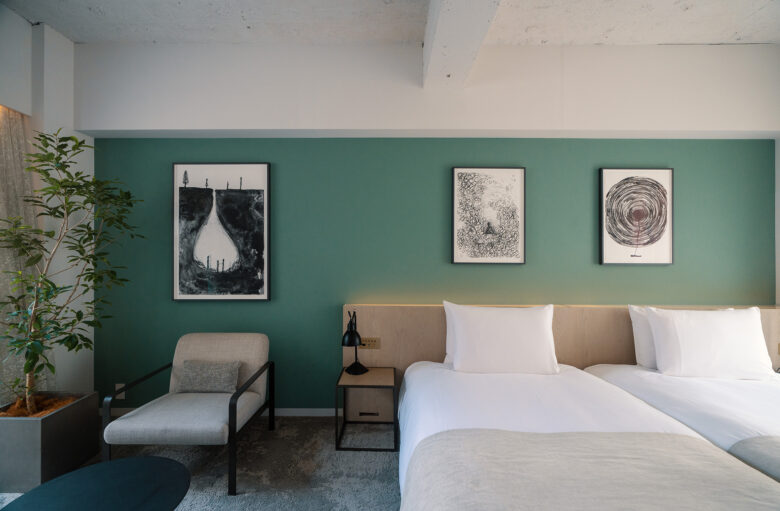ROOM 02 塩田千春 / CHIHARU SHIOTA


1972年大阪府生まれ。現在、ベルリンを拠点に活動。京都精華大学洋画科卒業後に渡独。ブラウンシュバイク美術大学(HBK)にてマリーナ・アブラモヴィッチ、ベルリン芸術大学(UDK)にてレベッカ・ホーンに師事。2008年に芸術選奨文部科学大臣新人賞を受賞。森美術館、南オーストラリア美術館、国立国際美術館など世界各地で個展開催。2015年には第56回ベネチア・ビエンナーレ国際美術展日本館代表を務めた。
黒や赤の糸を空間全体に張り巡らせた大型インスタレーションをはじめ、立体、写真、映像など多様な手法で作品を制作する。記憶、不安、夢、沈黙といったかたちを持たないものを表現してきた塩田の作品は、「生と死」や「不在の中の存在」など、普遍的で根源的な問いを観る者に投げかける。
客室に展示されている作品は、ドローイングのシルクスクリーン製版4点である。大学卒業後は絵画から離れ、様々な形態で制作していたが、2005年頃からドローイング作品も発表を始めた。ドローイングには同心円状の線がしばしば登場し、身体と宇宙空間、すなわちミクロとマクロの世界を同一的にとらえるような視点があらわれている。(塩田自身と思しき)人の腹部を起点とした円の重なりは竜巻のようであり、横たわる人と円の中心を結ぶ線は、母と子をつなぐ胎盤を思わせる。また、塩田の作品には、死後に還る場の象徴として大地や土がたびたび用いられてきた。地中に住む人々の描写は、大木が地下に根を張り巡らせているように、目に見える領域だけでなく見えない部分に潜む真実へと観る者を誘う。無数の破片が空間を覆い尽くすように描かれた作品は、人影とテーブルの存在も垣間見え、かつてあった部屋の様子を彷彿とさせる。
ドローイング作品には、インスタレーション作品などに至るまでの意識や過程、そして自身の思いや体験を出発点に制作を続ける塩田の根幹部分を見ることができるかもしれない。
Chiharu Shiota was born in Osaka in 1972. Currently based in Berlin, she moved to Germany after graduating from the Oil Painting Course at Kyoto Seika University. There she studied under Marina Abramović at the Braunschweig University of Art (HBK) and Rebecca Horn at the Berlin University of the Arts (UdK).
In 2008, she received the Art Encouragement Prize from the Japanese Minister of Education, Culture, Sports, Science and Technology. She has held solo exhibitions at museums around the world, including the Mori Art Museum in Tokyo, the Art Gallery of South Australia, and the National Museum of Art, Osaka. In 2015, Shiota created the installation in the Japanese pavilion at the 56th Venice Biennale.
Shiota creates artworks using diverse methods, from her distinctive large-scale installations with black and red threads stretched around the entire space to sculpture, photography, and videography. Her work expresses intangible ideas like memory, anxiety, dreaming and silence, confronting the viewer with universal and fundamental questions about life and death or presence within absence. Four silk-screened drawings are exhibited in this room.
Shiota moved away from painting toward other forms of artistic creation after completing her studies at university, but began showing drawings around 2005. The frequent appearance of concentric lines expresses a perspective that seeks to grasp body and cosmos—in other words, the microscopic and macroscopic world—at the same time.
In one work, the overlap of circles beginning from the abdomen of a human figure (presumably the artist herself) resembles a tornado. In another, the line connecting a person lying down and the centre of a circle suggests the placental link between mother and child. Shiota has also used earth and soil in her work to represent a place returned to after death.
The depiction of people living underground in another work invites the viewer to perceive the truths hidden not just in visible but also in invisible areas, much as a large tree spreads its roots deep underground.
Another work is drawn in innumerable fragments that fill the space apart from the glimpsed presence of a person’s shadow and a table, reminiscent of a scene in a room that once existed.
These drawings offer a view of the awareness and process behind Shiota’s installations, revealing her most fundamental nature as she continues to create based on her feelings and experiences.

